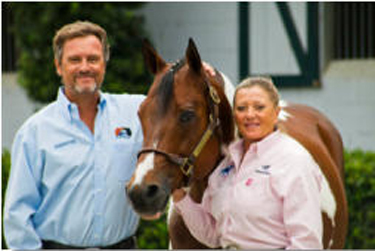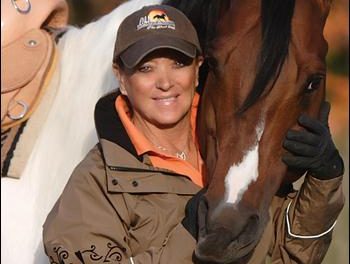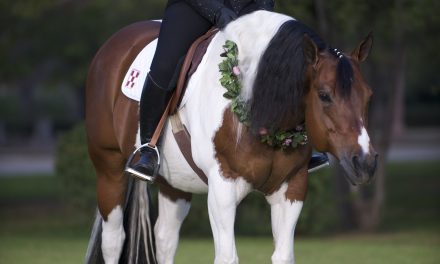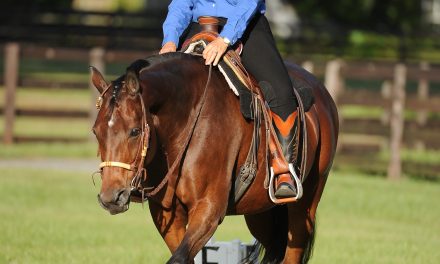Palm Partnership Training
 Last month we talked about being prepared for riding in winter conditions. In this article, I’ll share some tips on how to stay safe while riding in the winter.
Last month we talked about being prepared for riding in winter conditions. In this article, I’ll share some tips on how to stay safe while riding in the winter.
Riding Indoors
If bad weather forces you to ride indoor for any length of time, you will have to be creative to keep you and your horse interested in the work. Patterns, frequent changes of gait, and frequent changes of direction within many different figures are great training and conditioning techniques that make the work interesting. Another great way to keep the training period longer and lighter to minimize sweat build up is to do a variety of maneuvers—turn on the forehand, turn on the haunches, and yielding. Also, do not stay in the trot or canter very long.
I think that the most important safety issue while riding inside in the winter is to know your weather outside. If snow or ice falls off the roof when the sun warms the roof, this usually will spook a horse because he cannot see it and is spooked by the sound. Ice that forms from even a small amount of moisture on the roof of your indoor arena may not be obvious, but it still can be dangerous if it fall and startles the horse or hits him or both of you. The rider can be surprised too, and that is not fun. If you have the conditions for this potential safety hazard, be light on your training session and perhaps stay on the ground.
I love our training courses when training inside in the winter. You can always change the course or ride segments and thereby keep indoor training interesting. You will find this training in our Palm Partnership Training™ Courses, Part 1 and our newly completed Part 2. Also, our Agility Courses will give you lots to train in your ground training.
Riding Outside
If you ride outside in an arena that is free of snow, your biggest problem may be areas of ice and rutty ground. Hard ground is not desirable footing at any time, but it also is the reality of winter. Try to work in the best area of the arena, and keep your workouts short and more frequent. If the footing in the outdoor arena is really bad, it could sore your horse’s feet and/or cause lameness. In this case, a quiet dirt road or the side of a quiet paved road might offer better footing.
Riding in Snow
Riding in fresh snow can be one of the most wonderful riding experiences, and it is one of my favorites—talk about a winter wonderland! However, there are a few extra things you need to think about to make riding in snow fun, safe, and comfortable for your horse.
First, make sure there is not a crust under the fresh snow that could cut your horse’s legs as they break through it. If you are not sure about this, walk through the snow yourself or lead your horse through the snow on a longe line and see what the conditions are and how he handles it.
It is important to keep ice and snow from compacting in the horse’s hooves, especially if the horse is shod. This build up can cause slipping because the shoes will not touch the ground and could cause injury and even lameness if you are not careful. If your horse is barefoot, keep his hooves trimmed so that they hold less snow and have better traction. If your horse is shod and you ride in the snow often, you might want to use rubber rim pads or leather pads with the shoes. Ice caulks or borium on the shoes is a must for winter riding. Whether your horse is shod or barefoot, petroleum jelly or WD40 on the bottom of the hooves will help keep snow from accumulating there. Always keep a hoof pick in your pocket while riding outside in the snow. If your horse’s hooves build up in snow, get off and clean his feet!
When you ride in the snow, you must know the terrain and your route well. The tragic winter riding scene in the movie The Horse Whisperer is a good example of how things can go from wonderful to horrible when you stray from known territory. Try to avoid areas with ditches, branches under the snow, or any other extreme terrain variations. If you are riding on a trail in a forest, remember that the light will fade sooner than in the open and you could get lost easily if you cannot see the sun. Do not forget your compass!
Riding in the snow is harder work than in regular footing and, therefore, it is a real workout for your horse. Plan your time and speed accordingly. I recommend riding at a slower pace both for this reason and because of hidden objects in the snow. If you are lucky enough to have perfect conditions, trot or canter a short period of time for some of the most fun riding you have ever had. It is like riding in slow motion!
If you are a competitor in the summer, or trail ride long hours, or do endurance rides, then riding in the winter is a must. If you let the entire winter go by and you do not ride, you will pay the price when you start up again. And, as you and your horse grow older, it will catch up with you faster and faster. You will face frustration because you and your horse are sore, or your horse will be resistant because he is out of practice. You also will be frustrated if you are used to riding well and you and your horse have lost some edge from the lay off. Remember, riding is a sport, and I do not know of any sport that you can train for only seasonally and expect to do well. You will be happier and more successful if you keep riding during the winter, and your horse will be happier too.
For more information about Lynn Palm’s courses and training materials, please visit www.lynnpalm.com or call 800-503-2824.




